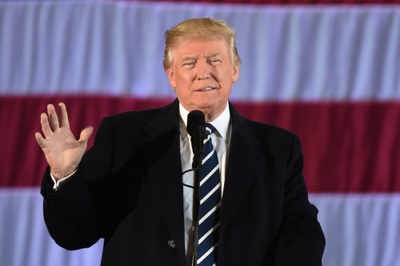- News
- India News
- Donald Trump’s H-1B stand may hit Indian tech companies
Trending
This story is from December 12, 2016
Donald Trump’s H-1B stand may hit Indian tech companies
As Donald Trump prepares to take over the White House, India will have to adjust its strategies on movement of skilled professionals to the US.

As Donald Trump prepares to take over the White House, India will have to adjust its strategies on movement of skilled professionals to the US.
NEW DELHI: As Donald Trump prepares to take over the White House, India will have to adjust its strategies on movement of skilled professionals to the US.
In an apparent reference to the current hot-button case against Disney World, Trump told an Iowa rally, “We will fight to protect every last American life. During the campaign, I also spent time with American workers who were laid off and forced to train.Foreign workers were brought in to replace them. We won’t let this happen any more.” Among his first actions after winning, Trump played a proactive role to keep air conditioning company Carrier from relocating to Mexico.
India has come in for special mention not merely by Trump but by successive presidential candidates over the past decade, with the word “bangalored” becoming an acceptable verb. The 1990 H-1B visa programme allows US employers to import up to 65,000 foreign workers with “highly specialised knowledge”. However, US studies have said the top users of the H-1B visa were outsourcing companies, mainly from India.
Trump can reduce the cap on H-1B visas or raise the fees or auction them. He could also order that H-1B workers have to be paid higher wages which would make Americans more competitive.
The first step was already attempted in 2004 when H1B cap came down from 195,000 to 65,000. This resulted in a number of companies taking entire back-end businesses to countries like India. It also resulted in the growth of Indian companies setting up facilities and offices in the US, and taking Indian techies from here on the intra-company L visa category. Either way, the higher priced American worker found himself/herself replaced, and large parts of company operations moved to foreign countries like India and China.
It would be impossible to go against the logic of market forces by keeping jobs and operations in high cost locations in the US. It’s the same in India. Whatever the route, its clear both the Indian government and India Inc as well as US companies and the Trump administration will have to find new ways of adjusting to global realities.
When PM Narendra Modi had his first conversation with Trump, this issue was singularly missing . While the government will have to respond to demands from Indian industry to intercede with the US on visas, government and industry together will have to work on newer strategies on movement of skilled persons.
In an apparent reference to the current hot-button case against Disney World, Trump told an Iowa rally, “We will fight to protect every last American life. During the campaign, I also spent time with American workers who were laid off and forced to train.Foreign workers were brought in to replace them. We won’t let this happen any more.” Among his first actions after winning, Trump played a proactive role to keep air conditioning company Carrier from relocating to Mexico.
India has come in for special mention not merely by Trump but by successive presidential candidates over the past decade, with the word “bangalored” becoming an acceptable verb. The 1990 H-1B visa programme allows US employers to import up to 65,000 foreign workers with “highly specialised knowledge”. However, US studies have said the top users of the H-1B visa were outsourcing companies, mainly from India.
Trump can reduce the cap on H-1B visas or raise the fees or auction them. He could also order that H-1B workers have to be paid higher wages which would make Americans more competitive.
But it could send out more operations to lower cost countries. Increasing the cap would open up more jobs for Americans but could attract many more foreigners like Indians who could do the job for less pay. It’s anever-ending dilemma.
The first step was already attempted in 2004 when H1B cap came down from 195,000 to 65,000. This resulted in a number of companies taking entire back-end businesses to countries like India. It also resulted in the growth of Indian companies setting up facilities and offices in the US, and taking Indian techies from here on the intra-company L visa category. Either way, the higher priced American worker found himself/herself replaced, and large parts of company operations moved to foreign countries like India and China.
It would be impossible to go against the logic of market forces by keeping jobs and operations in high cost locations in the US. It’s the same in India. Whatever the route, its clear both the Indian government and India Inc as well as US companies and the Trump administration will have to find new ways of adjusting to global realities.
When PM Narendra Modi had his first conversation with Trump, this issue was singularly missing . While the government will have to respond to demands from Indian industry to intercede with the US on visas, government and industry together will have to work on newer strategies on movement of skilled persons.
End of Article
FOLLOW US ON SOCIAL MEDIA










